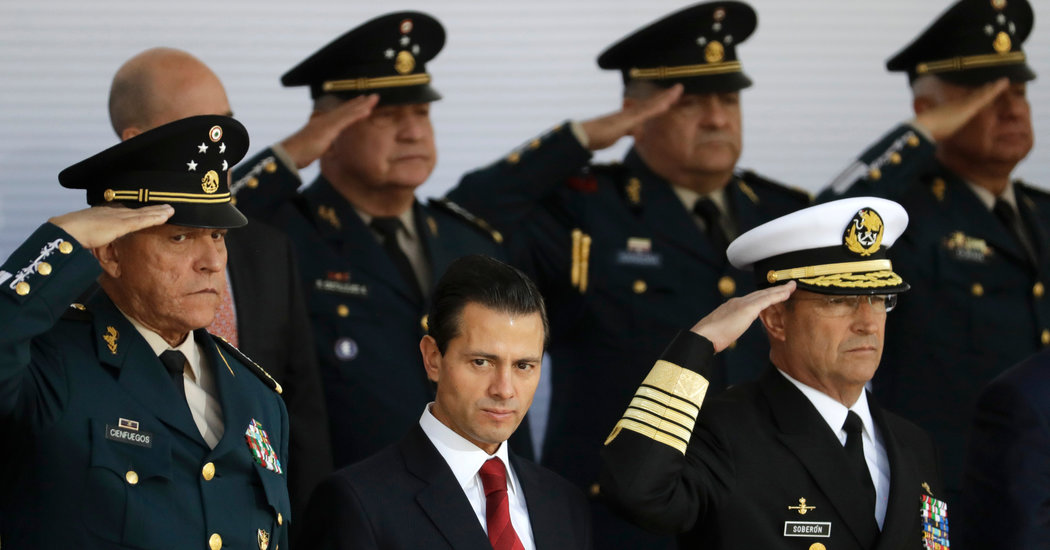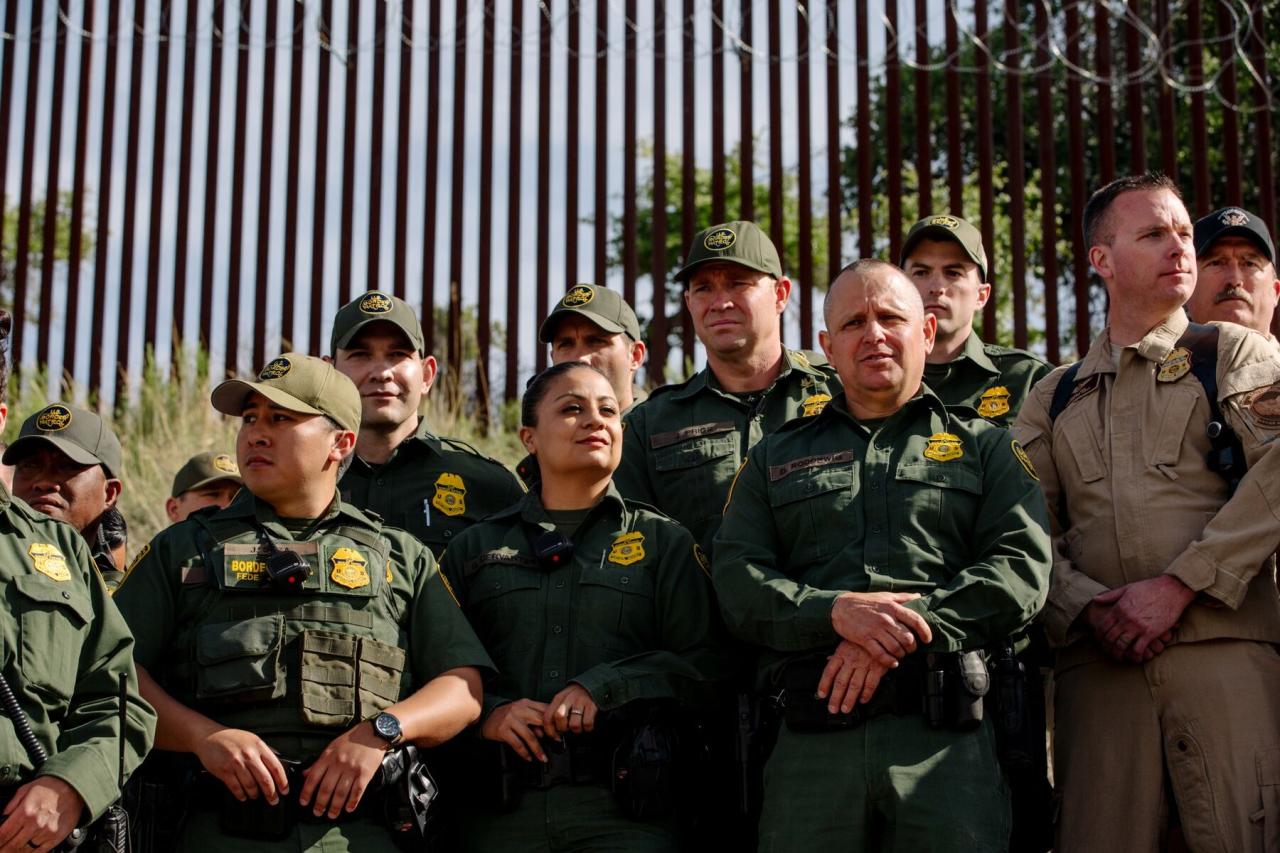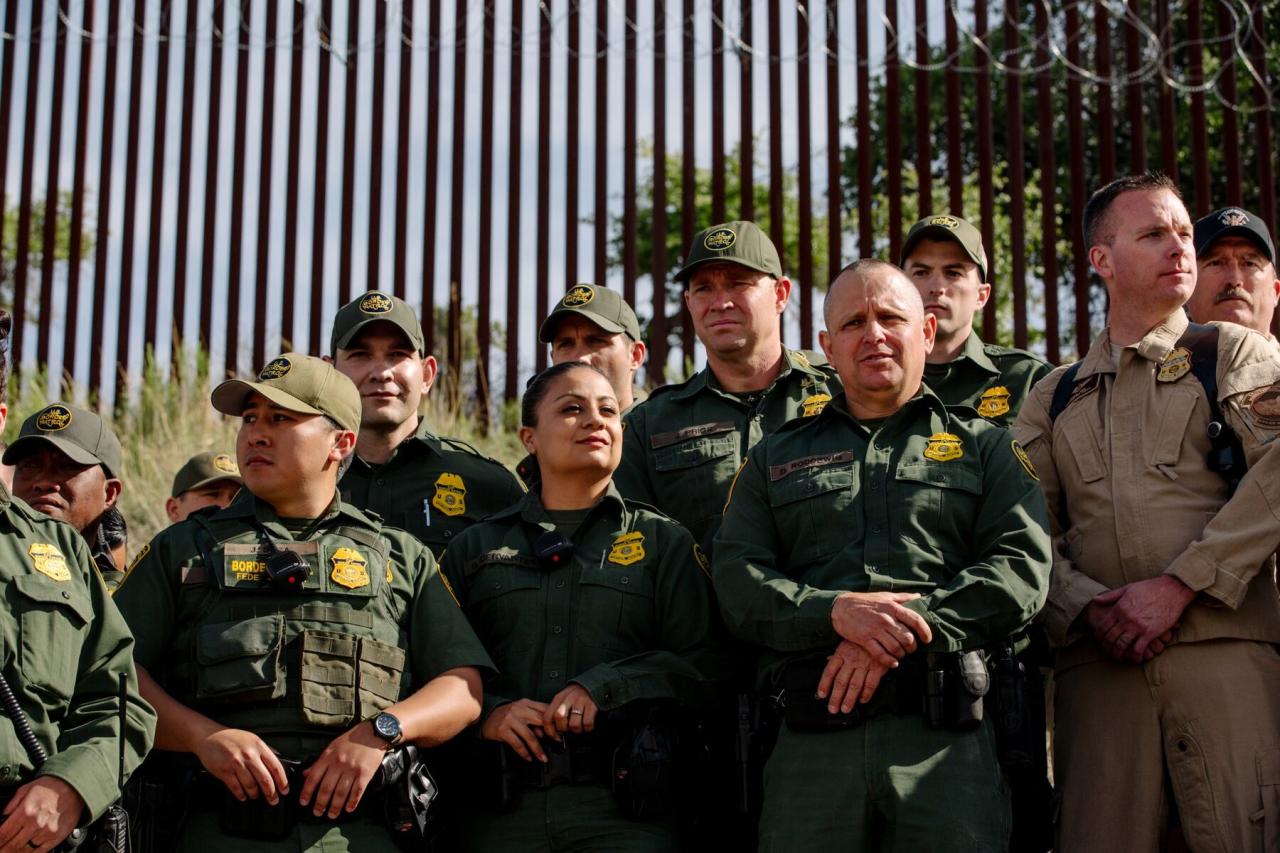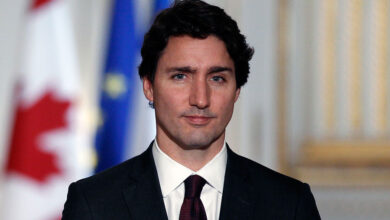Opinion Mexico Trump Threats: This post delves into the complex relationship between the US and Mexico, focusing on the significant impact of former President Trump’s rhetoric and policies. We’ll examine the historical context, Trump’s specific statements and actions, and the diverse reactions in both countries. From the economic fallout to societal shifts, this analysis explores the multifaceted consequences of these threats.
The article will use a chronological approach, starting with the historical background of US-Mexico relations, progressing to Trump’s specific policies and statements, and culminating in an evaluation of the lasting implications. It will present key events in a clear and concise manner, with supporting data where applicable, providing readers with a comprehensive understanding of this contentious issue.
Historical Context of U.S.-Mexico Relations
The relationship between the United States and Mexico has been complex and often fraught with tension, shaped by factors ranging from territorial disputes to economic disparities and political ideologies. This history, while marked by periods of cooperation, is also punctuated by conflicts and misunderstandings. Understanding this context is crucial for navigating the present and future of bilateral relations.The United States and Mexico share a long border and intertwined histories, influencing their interactions in significant ways.
From the era of westward expansion to the present day, both countries have experienced periods of cooperation and conflict, which have profoundly impacted their mutual understanding and perceptions.
Evolution of the U.S.-Mexico Relationship
The history of the U.S.-Mexico relationship is a tapestry woven with threads of cooperation, conflict, and evolving perspectives. This evolution has been influenced by major historical events, shifting political landscapes, and the actions of key leaders in both nations.
| Date | Event | Key Figures |
|---|---|---|
| 1846-1848 | Mexican-American War | James K. Polk (US President), Antonio López de Santa Anna (Mexican President) |
| 1848 | Treaty of Guadalupe Hidalgo | Nicholas Trist (US diplomat), representatives from both nations |
| 1910-1920 | Mexican Revolution | Francisco Madero, Venustiano Carranza, Álvaro Obregón (Mexico), Woodrow Wilson (US President) |
| 1942-1945 | World War II | Franklin D. Roosevelt (US President), Manuel Ávila Camacho (Mexican President) |
| 1994 | North American Free Trade Agreement (NAFTA) | Bill Clinton (US President), Carlos Salinas de Gortari (Mexican President) |
| 2008-2009 | Economic Recession | George W. Bush (US President), Felipe Calderón (Mexican President) |
Role of Political Leaders in Shaping Public Opinion
Political leaders play a critical role in shaping public perception of international relations. Their rhetoric, actions, and policies significantly influence how citizens in both countries view the relationship between the U.S. and Mexico. The rhetoric and actions of leaders during times of tension or conflict often amplify existing prejudices or anxieties. Leaders who prioritize diplomacy and cooperation, conversely, can foster mutual trust and understanding.
Furthermore, the specific policies and approaches of leaders shape the economic and social interactions between the two nations.
Public Opinion in Both Countries
Public opinion in both the U.S. and Mexico regarding their bilateral relationship has fluctuated significantly over time. Public opinion is a complex and multifaceted phenomenon, shaped by factors including economic conditions, cultural exchanges, and historical events. These factors influence how citizens in both countries perceive their shared history and their interactions with one another. For example, economic anxieties or concerns about immigration often become focal points in public discourse.
The role of the media in shaping public opinion cannot be understated. News outlets often focus on particular aspects of the relationship, which may not always reflect the full picture. This can influence public perception and attitudes.
Trump’s Statements and Policies Towards Mexico
Donald Trump’s presidency was marked by a distinctive and often contentious approach to U.S.-Mexico relations. His rhetoric and policies towards Mexico were frequently characterized by a focus on perceived economic and security threats, leading to a strained bilateral relationship. This approach contrasted sharply with previous administrations and significantly impacted trade, immigration, and security cooperation between the two countries.Trump’s policies aimed to renegotiate the North American Free Trade Agreement (NAFTA), impose tariffs on Mexican goods, and build a wall along the U.S.-Mexico border.
These actions, often presented as necessary to protect American interests, resulted in substantial economic and political consequences for both nations.
Specific Statements Regarding Mexico, Opinion mexico trump threats
Trump frequently criticized Mexico for allegedly contributing to illegal immigration and taking advantage of the U.S. economically. His pronouncements were often highly publicized and included accusations of Mexico’s involvement in drug trafficking and its handling of illegal immigration. Key examples of his statements included public declarations that Mexico was paying for the wall and that Mexico was a “very dangerous” country.
He also frequently blamed Mexico for the economic challenges facing the United States.
Trump’s Policies Targeting Mexico
Several policies were enacted or proposed by Trump’s administration that directly targeted Mexico. These included the renegotiation of NAFTA, resulting in the United States-Mexico-Canada Agreement (USMCA), which aimed to address concerns about trade imbalances. Further, Trump initiated the construction of a wall along the U.S.-Mexico border, a highly controversial proposal with significant cost implications.
Examples of Trump’s Rhetoric and Actions
Trump’s rhetoric often focused on national security concerns, linking Mexican immigration to drug trafficking and crime. He used strong language, such as referring to Mexico as a “rapist country” and a “dangerous country”. These statements generated considerable international criticism and contributed to a tense atmosphere between the two nations. His administration imposed tariffs on Mexican goods, citing unfair trade practices.
These tariffs were intended to encourage Mexico to renegotiate trade agreements more favorably to the United States. Importantly, these actions had noticeable impacts on various sectors of the U.S. economy and the Mexican market.
Summary Table
| Statement/Policy | Context | Impact |
|---|---|---|
| Accusations of Mexico contributing to illegal immigration and taking advantage of the U.S. economically | Underlying belief that Mexico was not cooperating sufficiently on immigration and engaging in unfair trade practices | Strained bilateral relations, fueled public debate |
| Renegotiation of NAFTA (resulting in USMCA) | Aimed to address perceived trade imbalances and protect U.S. industries | Resulted in a new trade agreement but did not fully resolve the concerns raised by Trump |
| Tariffs on Mexican goods | Intended to pressure Mexico to renegotiate trade terms | Led to economic consequences for both countries, including potential trade wars |
| Construction of a border wall | Presented as a solution to illegal immigration and drug trafficking | Highly controversial, with significant cost implications and environmental concerns |
Public Reaction in the U.S. to Trump’s Threats
Trump’s pronouncements regarding Mexico often sparked a wide spectrum of reactions within the United States, encompassing diverse viewpoints and political stances. These responses ranged from staunch support to outright condemnation, reflecting the deeply divided nature of American society. The ensuing political debates highlighted the complexities of international relations and domestic policy, while the media’s coverage played a crucial role in shaping public perception.The American populace reacted to Trump’s threats in a manner that was profoundly shaped by political affiliations and personal beliefs.
Understanding these reactions necessitates examining the diverse viewpoints expressed across different segments of society.
Trump’s threats against Mexico are definitely a hot topic, but it’s worth considering how these political pronouncements relate to real-world events. For example, recent events like the Martinez refinery fire and the subsequent protests involving Rickey Henderson and immigrant groups, as detailed in this article , highlight the complex interplay between economic factors, social tensions, and political rhetoric.
Ultimately, these broader issues all contribute to the overall narrative surrounding Trump’s approach to Mexico.
Different Perspectives on Trump’s Actions
Various segments of the American population held contrasting views on Trump’s approach to Mexico. Supporters often lauded his assertive stance, viewing it as a necessary measure to protect American interests and jobs. They believed his tough rhetoric and policies were effective tools for achieving favorable trade deals and border security. Conversely, critics argued that his actions were harmful to diplomatic relations, potentially damaging the U.S.’s standing on the world stage.
Political Debates Surrounding Trump’s Policies
The political landscape was heavily influenced by the debates surrounding Trump’s policies. Republican politicians generally supported his strategies, emphasizing the importance of securing the border and renegotiating trade agreements. Conversely, Democrats often criticized these policies, highlighting their potential negative impacts on bilateral relations and economic stability. The resulting debates extended beyond political platforms, affecting public discourse and influencing policy outcomes.
Media Coverage of Trump’s Threats and Their Impact
Media outlets presented various interpretations of Trump’s threats. Some outlets portrayed his actions as necessary for national security, while others focused on the potential negative consequences for international relations. The media’s coverage, whether supportive or critical, profoundly impacted public opinion and shaped the ongoing debate. The constant media coverage and analysis of Trump’s statements often amplified the tension between the U.S.
and Mexico, and contributed to the political climate of the time.
Comparison of Viewpoints Across Political Parties
| Political Party | General Viewpoint | Specific Concerns/Arguments |
|---|---|---|
| Republican | Generally supportive of Trump’s approach, emphasizing border security and renegotiating trade deals. | Believed tough rhetoric and policies were effective tools for achieving favorable trade deals and securing the border. |
| Democrat | Generally critical of Trump’s approach, highlighting potential negative impacts on bilateral relations and economic stability. | Argued that his actions could harm diplomatic relations and damage the U.S.’s standing on the world stage. |
| Independent | Held diverse opinions, with some supporting Trump’s actions and others expressing concern about the potential consequences. | Some highlighted the economic implications, while others focused on the damage to international relationships. |
Public Reaction in Mexico to Trump’s Threats
Trump’s pronouncements on Mexico, ranging from trade disputes to border security, sparked a significant and multifaceted response within Mexican society. The rhetoric often painted a stark picture of conflict, prompting a diverse array of reactions from citizens, politicians, and the business community. This reaction, while complex, provides valuable insight into the sensitivities and concerns surrounding the bilateral relationship.The Mexican public’s response to Trump’s policies wasn’t monolithic.
While some individuals and groups voiced strong opposition, others expressed varying degrees of concern or even acceptance. The economic and political repercussions of these threats were felt across different sectors of Mexican society. This analysis delves into the nuances of the Mexican public’s reaction, examining its impact on domestic politics and economics, and outlining the Mexican government’s diplomatic responses.
Mexican Public Sentiment
The Mexican public’s response to Trump’s statements and policies was characterized by a blend of anger, apprehension, and resolve. Many Mexicans viewed the pronouncements as disrespectful and economically damaging, sparking protests and demonstrations in various cities. Public opinion polls revealed a growing sense of nationalism and a determination to defend Mexican interests. Social media played a significant role in mobilizing public opinion and disseminating information.
Trump’s threats towards Mexico are definitely a hot topic right now, sparking a lot of opinions. But amidst all the political drama, have you considered how to smoothly transition your old email accounts to a new platform? Luckily, there are excellent tools out there to help with that, such as the best email migration tools. No matter what side of the political fence you’re on, efficient email management is always a smart move.
Hopefully, the threats to Mexico will soon be resolved and calm will prevail.
Impact on Mexican Politics and Economics
Trump’s threats undeniably impacted Mexican politics. The discourse surrounding the bilateral relationship became a central theme in political debates, influencing election campaigns and shaping the political agenda. Economically, there were concerns about the potential for decreased trade with the US, job losses in export-oriented sectors, and a decline in foreign investment. These concerns were further amplified by uncertainty about the future of the North American Free Trade Agreement (NAFTA).
Mexican Government’s Diplomatic Responses
The Mexican government responded to Trump’s threats with a mix of diplomatic engagement and assertive counter-measures. Negotiations and diplomatic channels were frequently utilized to address specific concerns and disagreements. The Mexican government also publicly emphasized its commitment to defending its national interests and economic sovereignty.
Contrasting Reactions and Intensity
| Category | Reaction | Intensity | Examples |
|---|---|---|---|
| Economic Concerns | Widespread anxiety about trade losses and job displacement. | High | Business leaders voicing concerns about reduced exports and investment. Public demonstrations in export-dependent areas. |
| Political Tensions | Rise in nationalism and a determination to defend Mexican interests. | Medium-High | Increased political rhetoric emphasizing national sovereignty. Public statements from politicians and activists demanding a firm response. |
| Diplomatic Actions | Continued dialogue and negotiations with the U.S. | High | Participation in trade negotiations and diplomatic meetings. Public pronouncements emphasizing the importance of maintaining a strong relationship. |
| Social and Cultural Responses | Outrage at perceived disrespect and threats. | High | Social media campaigns expressing disapproval. Public protests and demonstrations. |
Economic Impact of Trump’s Threats

Trump’s threats toward Mexico, often couched in terms of economic penalties, carried significant potential for disrupting the complex economic relationship between the two nations. The implications ranged from direct trade disruptions to broader shifts in investment patterns and employment dynamics. Understanding the potential consequences requires examining the intricate web of economic ties between the U.S. and Mexico.The economic interdependence between the U.S.
and Mexico is deeply rooted in shared supply chains, trade agreements, and investment flows. Any significant disruption to this relationship, particularly one driven by political tension, could have far-reaching and potentially negative effects on both economies. The anticipated economic impacts extended beyond the immediate period of the threats and likely lingered for an extended period.
Potential Impacts on U.S. Trade
The U.S. and Mexico are major trading partners, with substantial bilateral trade flows under the North American Free Trade Agreement (NAFTA). Disruptions to this trade relationship could negatively affect U.S. businesses relying on Mexican imports for components, raw materials, or finished goods. Reduced trade volumes could lead to higher prices for consumers and production bottlenecks for manufacturers.
Potential Impacts on Mexican Trade
Mexico’s economy is heavily reliant on exports to the U.S., particularly in sectors like automobiles, agricultural products, and electronics. Trade restrictions or tariffs imposed by the U.S. could significantly harm Mexican export industries, potentially leading to job losses and economic downturn in specific regions. Mexican businesses would face increased costs and challenges in accessing the U.S. market.
Impact on Investment Flows
Investment flows between the two countries are substantial. Threats of economic retaliation could deter foreign direct investment (FDI) into Mexico from U.S. companies and other investors. Reduced investment could slow economic growth and development in Mexico, impacting job creation and overall prosperity. Conversely, U.S.
investors could also face obstacles in Mexican markets.
Impact on Employment in Both Countries
The interconnectedness of supply chains and production processes in both countries implies that disruptions in one economy often translate to challenges in the other. Trade restrictions and reduced investment could lead to job losses in industries reliant on cross-border trade and manufacturing. The impact would likely be felt in specific sectors and regions dependent on the bilateral relationship.
Consequences for Specific Industries
The automotive industry, for example, is heavily reliant on cross-border production and trade. Disruptions to this sector could result in significant economic losses for companies operating in both countries. Similarly, agricultural exports and manufacturing activities could also be negatively impacted.
Economic Data Comparisons (Hypothetical)
This table demonstrates the potential consequences of economic threats. It is crucial to emphasize that these figures are hypothetical and represent possible scenarios. Actual data would depend on the specific nature and duration of any implemented measures.
| Metric | Before Threats (2018) | After Threats (Estimated) |
|---|---|---|
| U.S. GDP Growth Rate | 2.9% | 2.5% |
| Mexico GDP Growth Rate | 2.0% | 1.5% |
| U.S.-Mexico Bilateral Trade Volume | $600 Billion | $550 Billion |
| U.S. Employment in Export-Oriented Sectors | 10 Million | 9.5 Million |
| Mexican Employment in Export-Oriented Sectors | 5 Million | 4.5 Million |
Societal Impacts of the Rhetoric
Trump’s rhetoric towards Mexico significantly impacted the social fabric of relations between the two countries. The tone, often characterized by aggressive language and threats, created a climate of distrust and tension that extended beyond political discourse. This strained relationship manifested in various ways, affecting cultural exchange, immigration policies, and the overall perception of each nation.The constant barrage of pronouncements and accusations, often without factual basis, created a hostile environment.
This affected not just official government interactions but also permeated public discourse, contributing to a broader social climate of suspicion and animosity.
Trump’s threats toward Mexico are definitely grabbing headlines, but it’s interesting to see how Governor Newsom is bucking the Democratic party line on trans athletes. He’s seemingly mirroring the majority public opinion on this issue, a move that’s drawing a lot of attention, and perhaps hinting at a shift in political discourse. This all makes you wonder if there’s a broader trend of political figures responding to public sentiment, even if it means going against their own party.
Maybe the Mexico threats are less about a calculated political strategy and more about a reflection of a deeper societal shift. Newsom becomes most prominent democrat to buck the party and echo majority public opinion on trans athletes is a case in point. Ultimately, the big question remains: how will these shifts in public opinion impact future political strategies, especially regarding the threats against Mexico?
Potential Impacts on Social Relations Between the U.S. and Mexico
The rhetoric fostered a sense of antagonism between the two countries. Public perception, influenced by media coverage and political commentary, often portrayed Mexicans in a negative light, feeding stereotypes and fueling social division. This polarization hindered the ability to address shared concerns and fostered a sense of animosity that transcended political agendas.
Effects on Cultural Exchange and Cooperation
Cultural exchange programs and initiatives were potentially impacted by the heightened tensions. Uncertainty and fear could have discouraged participation, both from U.S. and Mexican citizens. Travel, tourism, and artistic collaborations were possibly affected, with individuals and organizations hesitant to engage in cross-border activities. This negative impact could have been particularly significant in areas where cultural exchange had previously flourished.
Analysis of the Impact on Immigration Policies and Attitudes
Trump’s policies and rhetoric on immigration significantly altered public attitudes towards Mexican immigrants in the United States. Negative narratives and threats of border enforcement measures created a climate of fear and apprehension, impacting the well-being of immigrant communities. The rhetoric contributed to a hardening of public opinion towards immigration in general. Moreover, this negative rhetoric could have influenced Mexican communities in the United States.
Influence on the Image of Both Countries
The rhetoric created a negative image of both the U.S. and Mexico on the global stage. The U.S., perceived as confrontational and potentially protectionist, could have alienated allies and partners. Mexico, facing threats and accusations, might have been portrayed as a country struggling to manage its image in the international arena. This perception could have affected trade relations, foreign investment, and international standing.
Examples of How This Rhetoric Might Have Affected Social Trust Between the Countries
One example of the rhetoric’s impact on social trust is the decline in cross-border tourism. As perceptions of hostility intensified, tourists might have become less inclined to visit each other’s countries. Likewise, business collaborations between the two countries might have faced challenges. The rhetoric, while not always directly causing damage, could have created an atmosphere where mistrust and suspicion were more likely to surface, impacting all facets of the relationship.
Long-Term Implications of the Threats
Trump’s rhetoric and threats towards Mexico, while often characterized as politically motivated, have the potential to leave deep and lasting scars on the bilateral relationship. The damage transcends short-term political gains, potentially altering the landscape of international relations and shaping future interactions for decades to come. The underlying tensions exposed by these statements, if not addressed, could lead to a less predictable and cooperative future.The long-term implications of these threats are multifaceted, impacting not only the U.S.-Mexico relationship but also influencing international diplomacy and potentially affecting other nations.
These actions create a precedent that could be emulated by other countries in similar situations, potentially escalating global conflicts. Understanding these implications is crucial for navigating the future.
Potential Effects on the U.S.-Mexico Relationship
The repeated pronouncements and actions have fostered a climate of distrust and uncertainty. This erodes the foundation of decades of cooperation, built on shared economic interests and, in some instances, common security concerns. These concerns, if unaddressed, could lead to a significant shift in the nature of the relationship, moving away from the traditional transactional approach to one marked by heightened suspicion and a lack of mutual trust.
- Erosion of Trust: Repeated threats, often without concrete evidence or justification, chip away at the trust built over time. This eroded trust will be difficult to rebuild and can lead to future difficulties in resolving disputes or collaborating on common issues. This has been observed in other international relationships where trust was eroded over time, like the decline in relations between the United States and certain European nations following specific political incidents.
- Increased Risk of Retaliation: Mexico may adopt retaliatory measures, either economically or politically, to counter perceived threats. This retaliatory approach can create a vicious cycle, escalating tensions and potentially undermining existing agreements and trade partnerships. Historically, the US and Mexico have had a delicate balance in trade relations, and threats like these have had a ripple effect on the economic sectors of both countries.
- Reduced Cooperation on Shared Issues: A fractured relationship will make cooperation on issues like immigration, security, and drug trafficking more challenging. This lack of cooperation can exacerbate existing problems, and lead to more dangerous situations. For example, the lack of cooperation in combating drug trafficking can lead to more violence and instability in both countries.
Impact on International Relations and Diplomacy
The U.S.-Mexico relationship is a key element of international relations. The implications of strained relations extend beyond the bilateral context, influencing global diplomacy and potentially setting a precedent for other countries to adopt similar tactics in international disputes. This includes influencing the behavior of other nations facing similar economic or political issues.
- Reduced Credibility of International Agreements: If the U.S. fails to uphold commitments and diplomatic norms, it could erode the credibility of international agreements and institutions. This can undermine the rule of law and encourage similar behavior in other nations, making international relations less predictable and more conflict-prone. This can be seen in the declining trust in global organizations, such as the World Trade Organization, after certain political decisions.
- Increased Risk of Global Conflicts: A pattern of international tensions and threats can lead to escalation in other regions, creating a risk of global conflicts. A country’s actions and responses to threats can trigger similar responses in other regions. For instance, a strained relationship between two nations can set a precedent for disputes that escalate in other parts of the world.
- Weakening of Multilateralism: The emphasis on bilateralism and the disregard for multilateral agreements can weaken the overall framework of international cooperation. The US-Mexico relationship has been traditionally part of multilateral collaborations and agreements, and the strain on this relationship will affect the effectiveness of those collaborations.
Examples of Future Interactions
The way the U.S. and Mexico interact will likely be profoundly affected.
- Trade Disputes: Future trade negotiations may be fraught with suspicion and mistrust, leading to more contentious and prolonged negotiations. This is similar to trade disputes between other countries where trust and cooperation are lacking.
- Security Cooperation: Cooperation on security issues like drug trafficking and immigration may diminish, potentially increasing the threat of cross-border crime. This lack of trust could affect security agreements and collaborations.
- Immigration Policies: The relationship may become more adversarial on immigration issues, resulting in stricter border controls and fewer avenues for legal immigration. This could have significant humanitarian consequences and economic impacts on both nations.
Potential Scenarios for the Future of the Relationship
| Scenario | Description | Likely Outcome |
|---|---|---|
| Continued Hostility | The U.S. and Mexico maintain a confrontational stance, characterized by threats and a lack of cooperation. | Increased tensions, economic repercussions, and reduced cooperation on shared issues. |
| Escalation of Conflict | Threats escalate to more direct and harmful actions, including trade sanctions or military interventions. | Potential for a significant crisis, with unpredictable consequences for both nations and the international community. |
| Negotiated Resolution | Both nations engage in constructive dialogue and negotiations, leading to agreements that address underlying concerns. | Restoring trust and cooperation, allowing for greater collaboration on shared issues. |
Closing Notes: Opinion Mexico Trump Threats

In conclusion, Trump’s approach towards Mexico triggered significant reactions and had lasting effects on both nations. This analysis highlighted the complex interplay of political, economic, and social factors. The long-term implications remain uncertain, but the episode serves as a stark reminder of the potential damage that strong rhetoric and policies can inflict on international relations. Future interactions will likely be shaped by the lessons learned from this period.





